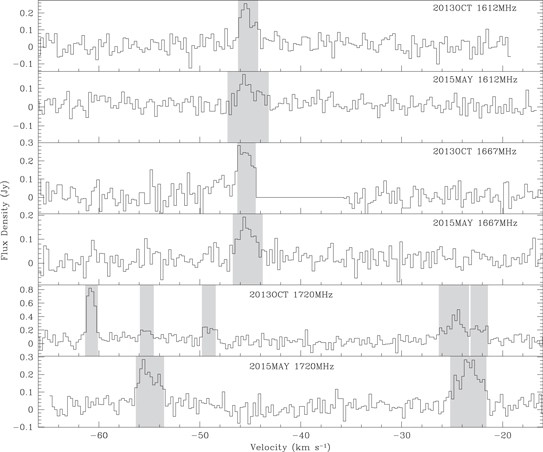In about 5 billion years, our sun will evolve to be a red giant, expanding out beyond the orbit of Venus. When our sun has used up its fuel, its core will collapse and its outer gas layer will be expelled by strong stellar winds. After being illuminated by the ultraviolet radiation of the hot luminous core, the dissipated gas layer will appear as a brightly coloured planetary nebula (PN). Planetary nebula can only last a few tens of thousands of years, compared to a typical stellar lifetime of several tens of billions of years.
At the early stage of its formation, a planetary nebula, almost invisible in optical bands, can be studied using observations at other frequency bands, such as radio frequencies.
Ground-state OH maser emissions at 18 cm (with frequencies corresponding to 1612 MHz, 1665 MHz, 1667 MHz and 1720 MHz) are widespread in the circumstellar envelopes during the asymptotic giant branch (AGB) phase. However, in PN phases after post-AGB phase, OH masers are rarely found. Among the ~3000 PNs, only 6 are found with ground-state OH maser emissions. Moreover, among the aforementioned 6 PNs, only 1 shows OH maser emission at 1720 MHz, indicating possible presence of shock waves.
Recently, Haihua Qiao, a PhD graduate student from Shanghai Astronomical Observatory (SHAO), studying at Curtin University with fund from China Scholarship Council, under supervision of Dr. Andrew Walsh from International Centre for Radio Astronomy Research, Curtin University and Dr. Zhiqiang Shen from SHAO, discovered the first PN exhibiting the 1720 MHz OH maser as the strongest transition, using the Australia Telescope Compact Array (ATCA). This target, IRAS 16333?4807, turns to be the seventh known case of an-OH-maser-emitting PN, exhibiting OH maser emission at 1612, 1667 and 1720 MHz, among which, OH maser emission at 1720 MHz is the strongest.
“There were some problems in the first observation around OH maser emission at 1667 MHz. Therefore, in one and a half year, we re-observed this target”. Qiao said, “then something amazing happened --- with OH maser emission at 1612 MHz and 1667 MHz remaining the same, the 1720 MHz masers show a variable spectrum. Besides, Zeeman splitting were detected in the 1720 MHz transition at two epochs, which suggests that the 1720 MHz masers may be formed in a magnetized environment.” This work has been published in Astrophysical Journal.

OH maser emissions of IRAS 16333-4807 observed at Oct. 2013 and May 2015, where shaded areas refer to OH maser emission channels.
Why do they choose this target? Qiao mentioned, PNs with ground-state OH masers are rare and precious, PNs with 1720 MHz OH maser are rarer, PNs with 1720 MHz OH maser as the strongest transition are even rarer. This target, IRAS 16333-4807, matches the above three requirements, which makes itself so precious.
Qiao further mentioned, “thanks to 1720 MHz OH maser, we estimated strength and direction of the magnetic field. It may trace short-lived equatorial ejections around the formation of the PN.”
"This PN also exhibits H2O maser emission at 22 GHz. Existence of both OH and H2O maser emissions indicates that the PN is still young. This study actually provides a way to study the evolution of PNs at their early stages.” Dr. Zhiqiang Shen said.
This target was observed in the Southern Parks Large-Area Survey in Hydroxy1 (SPLASH), a survey of the OH radical across the inner Galaxy. Another paper about this survey covering a sky area of approximately 160 square degrees, is in preparation and will show more interesting results.
Science Contact:
Haihua Qiao, Shanghai Astronomical Observatory, qiaohh@shao.ac.cn
News Contact:
Wenwen Zuo, Shanghai Astronomical Observatory, wenwenzuo@shao.ac.cn,34775125
Link to the research paper:
iopscience.iop.org/article/10.3847/0004-637X/817/1/37/meta
Link to Shanghai Astronomical Observatory:
www.shao.ac.cn